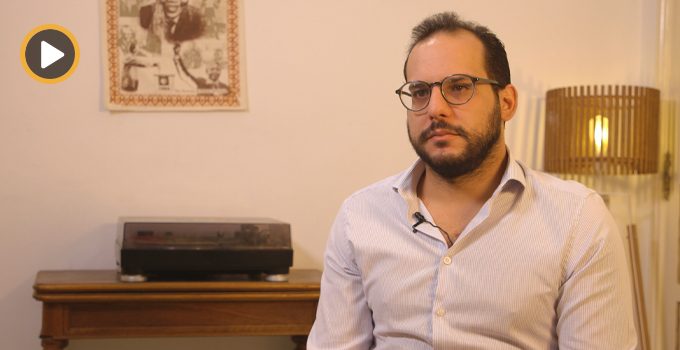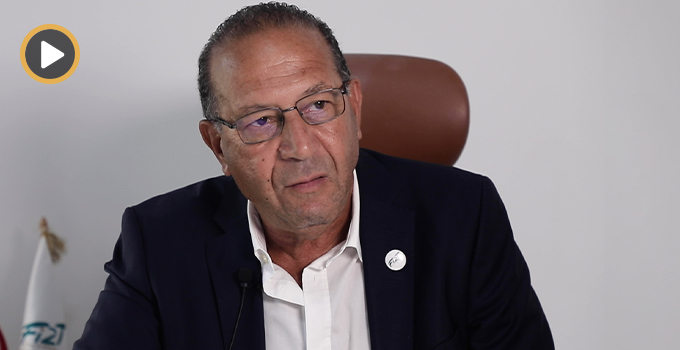Salah, encumbered by the slight arching of his back, climbs the slope with difficulty. He is surrounded by his flock and dogs. As they make their way, the sheep nibble on whatever sparse vegetation they can find. Here and there, walls signal the presence of private properties. « Just a few years ago, there was not a single wall, and this land provided food for our animals all year long », Salah recalls. Twice a day since the age of 15, Salah has come to this stretch of land between Manouba and Sanhaja. Back then, on a plot of 150 hectares, approximately 30 hectares were reserved as pasture for livestock. Ever since land owners started selling land by the meter, however, this space has shrunk, limiting the movement of flocks and forcing shepherds to travel farther to graze their animals. A few ocher-colored plots remain unclaimed [mssayba], providing some space for grazing—but not enough. Unable to feed all of his animals, Salah was forced to sell more than half of his flock. « I don’t have the resources to purchase feed. My one strength is my legs; which enable me to go out in search of pasture for my animals ».

Division of agricultural lands
But these spaces are becoming increasingly rare throughout Greater Tunis. The phenomenon of suburbanization, at the expense of agricultural lands, intensified during the 1980s. The figures speak for themselves; In the governorate of Manouba, 66.5% of buildings went up in banned areas, that is to say on irrigated public lands or in forests. In the governorate of Ben Arous, nearly 35% of buildings were built in protected areas. Finally, in the governorate of Ariana, this rate is estimated to be above 50% [1]. According to researcher in urban planning and development Hend Ben Othmane, « this phenomenon is characteristic of the rural outskirts of Greater Tunis where some land is still designated for agricultural use, but agricultural activity has decreased significantly ». She adds, « these spaces have been divided up by owners who thus act as illegal developers, having sold their land in plots of varying sizes according to the targeted social category ».
This is precisely what has taken place on the lands that Salah once roamed with his animals. In 2012, the owners began to sell plots ranging from 1,000 to 2,000 square meters to city-dwellers who dreamed of owning a villa and surrounding garden. The first reflex of these buyers: to erect a wall around the plot in anticipation of the beginning of construction. The landscape was quickly transformed from undulating stretches of land and olive groves to barren plots separated by grey walls. « This place was known for the quality of its grape vines and olive trees, but that was a long time ago! » Salah recounts, gesturing towards the horizon with his staff. How much longer will he be able to pasture his flocks here? Most of his family members have sold all of their livestock and purchased businesses in the town of Sanhaja. « Perhaps one day I too will have to sell everything », says Salah, catching his breath. « Decreased agricultural activity and production have forced some small-scale farmers to sell their plots and change activities », Ben Othman confirms.
Ineffective legal framework?
In the mid-1990’s, the total loss of agricultural land was an estimated 23 thousand hectares annually. Primarily the result of erosion and urbanization, these losses were concerning for public authorities who established « a relatively thorough legal and institutional framework » [2]. The 1983 Agricultural Land Protection Law set strict rules around the use of soil in Tunisia. It organized agricultural lands into three categories: banned areas, protected areas and areas subject to authorization. Only lands which fall into the latter category can be designated for other activities relating to investment or projects of public interest. There are also Urban Development Plans which regulate the use of soils on muncipal lands, but these, Ben Othman tells us, « quickly become obsolete due to significant delays in their elaboration and approval ». Institutionally, several organisms are supposed to regulate the urbanization of agricultural lands; one such structure is the General Commissariat of Regional Development. Overall, this legal and institutional framework « does not seem effective enough to suppress the progressive urbanization that is taking place at the expense of agricultural lands » it is noted in the article cited above.
Its author affirms that « upon the occasion of the creation of the governorate of Manouba [in 2000], local authorities were forced to close their eyes to the strong pressure that was placed upon agricultural lands. The administration itself removed the agricultural designation associated with a large part of its lands in order to put up administrative complexes ». According to the General Commissariat of Regional Development, « real estate pressure on agricultural lands in the region of Manouba is only increasing and will continue to sacrifice hundreds of hectares of agricultural land every year ». A significant proportion of agricultural lands is thus being put to other uses in order to respond to the demands of development: industrial zones, commercial complexes, public infrastructure and service activities. A study underway by the General Direction of National Development estimates that the surface area of agricultural land whose designated use was modified between 2011-2021 was equal to 1,370 hectares. Around these areas, the proliferation of informal neighborhoods will be difficult to stem. « Municipalities are overwhelmed by the uncontrolled growth of spontaneously-established neighborhoods, especially since 2012 », explains Ben Othman. She blames « the absence of a body attached to the municipality tasked with ensuring monitoring and decision-making in relation to urban violations ».

The danger of soil degredation
Although urbanization enables local development, it also destroys three soil functions vital to human beings and the environment: food production, climate control and water supply. Agriculture has long represented a central function in the governorate of Manouba, which is situated in the lower valley of the Medjerda river. Indeed, its geographical setting has been pivotal in the agricultural development and production for which the region is known. For instance, Manouba is the country’s primary producer of pears and artichokes. However, the progressive nibbling away of lands designated for agricultural activity threatens the soil’s fertility as well as its function to feed the population. Degraded soil does not easily resume its natural function. Furthermore, urban encroachment contributes to global warming, since soil that has been degraded can no longer absorb CO2. Finally, soil sealing leads to increased volumes of run-off to the detriment of ground water reserves, and results in higher risks of flooding.
In terms of biodiversity, Salah’s observations are clear: ever since the first buildings appeared, the region’s flora and fauna have been severely affected. « A number of plant species have disappeared. The diversity of bird life that abounded several years ago is no longer. And it’s been a long time since I’ve seen a fox or heard any wolves », he tells us, at once troubled and relieved. « Wolves are our enemies, they attack our flocks ». The dogs bark, Salah is suddenly on guard. A few cars pass by, leaving a cloud of dust in their wake. « Those are the owners of the land further down. They are building a villa that is several stories high ».
Will this mounting pressure on our ecosystems ever let up? « The challenge is to find the right balance between land needs for local development and housing on the one hand, and for the protection of agricultural zones on the other », notes Hend Ben Othman. In areas this close to cities like Oued Ellil or Manouba, one is hard pressed to imagine the possibility of reversing the current trend which favors urbanization. Not far from where Salah grazes his flock, a number of plots stretching across 331 hectares of land and managed by the Land Agency for Housing (AFH) promise the eventual installation of 60 thousand residents. A road project for the X20 which extends for 15 km cuts through part of the Manouba governorate. From where Salah stands with his animals, the various construction sites are visible in the distance, providing a clear image of the urban sprawl. « The city is advancing », he remarks. Built atop the lands that he has tread with his flocks for so many years, this new infrastructure is anything but reassuring for the seasoned shepherd: « What are we going to leave for future generations? » he wonders aloud.

[1] Studies by the Urban Agency of Greater Tunis (AUGT)
[2] Elloumi M. Agriculture périurbaine et nouvelles fonctions du foncier rural en Tunisie. In : Elloumi M. (ed.), Jouve A.-M. (ed.), Napoléone C. (ed.), Paoli J.C. (ed.). Régulation foncière et protection des terres agricoles en Méditerranée. Montpellier : CIHEAM, 2011. p. 159-169 (Options Méditerranéennes : Série B. Etudes et Recherches; n. 66)






iThere are no comments
Add yours